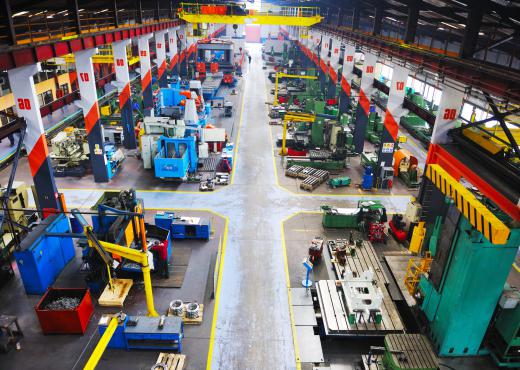At AboutMechanics, we're committed to delivering accurate, trustworthy information. Our expert-authored content is rigorously fact-checked and sourced from credible authorities. Discover how we uphold the highest standards in providing you with reliable knowledge.
What Is Demand Flow® Technology?
Demand Flow® Technology (DFT) is a manufacturing process that incorporates many different methods of streamlining and efficiency to produce products in the least amount of time according to customer demands. This means that Demand Flow® Technology utilizes concepts such as just-in-time inventory, lean manufacturing, and six sigma efficiency standards to maximize production quality and speed. The process of demand flow manufacturing is unique, however, in that it changes the typical assembly line approach to labor that most manufacturers use. It does this by requiring employees to move from station to station as work flow needs require in order to keep the production process operating smoothly and at peak levels at all times. The other key aspect of lean concepts that this type of flexible work force supports more efficiently is that Demand Flow® Technology is geared towards product runs specifically designed to meet current customer orders, instead of generating traditional batches to be stored for later anticipated demand.
The basic concept behind Demand Flow® Technology that was pioneered by the DemandPoint company in the US state of Colorado, is that a manufacturing or business process is most profitable when a continuous flow of product is produced to meet specific customer needs. This requires that the production process be continually changed on a daily basis to adapt to incoming sales figures. Both the control of the production of actual product as well as avoiding intermittent conditions of an idle labor force are key to Demand Flow® Technology working properly. Such precise control requires scientific and mathematical models for managing the process. These models were originally created by John R. Costanza in 1984, an operations management leader who has since worked with several prominent US manufacturers in a variety of industries to implement the technology.

Lean manufacturing is a method of improving production processes that was developed in Japan and later incorporated into US companies and elsewhere as they lost their competitive edge against more efficiently-produced Japanese products. One of the key requirements for an effective, continuous flow of production and labor resources being tied to sales is that of rapid telecommunications. Earlier versions of this process of Demand Flow® Technology were known as supply chain management, where separate divisions of a company were all tied together in a management network that attempted to accurately meet customer requirements. The advent of the Internet and the proliferation of portable communications such as cellular phones as of 2011 has made it more practical to create a true just-in-time production process at multiple levels of a company's hierarchy.

The methodology of Demand Flow® Technology, however, has specific strengths and weaknesses. Because it is designed to be a system with an ability at rapid adaptation to changing customer input, it is best suited to what is known as mixed-model production and to facilities that can rapidly retool to make a variety of products. This makes such facilities more efficient at low-volume production runs of a wide range of different products.
Companies that are geared towards producing just one main product in large volumes, where each workstation is highly-specialized, are less able to incorporate Demand Flow® Technology principles into their system. Workers cannot easily be cross-trained in highly-specialized environments, and the risk of accidents and manufacturing shut downs is high. Machinery that is also geared towards high-volume, standardized production schedules cannot be readily ratcheted up and down in the volumes of output that they generate.
Where Demand Flow® Technology works, it is known to scale back lead times from reception of an order to delivery by up to 90% over that of traditional manufacturing methodology. The driving force behind why the Japanese first perfected such concepts, however, was to eliminate costs built into a manufacturing process that did not add any direct value to the end product. The side effects of such a narrowly-focused improvement in efficiency, however, brought Japan to a dominant position in the global manufacturing marketplace, and their ideas have been increasingly adopted and adapted by western companies such as DemandPoint in the 20th and 21st centuries.
AS FEATURED ON:
AS FEATURED ON:












Discuss this Article
Post your comments